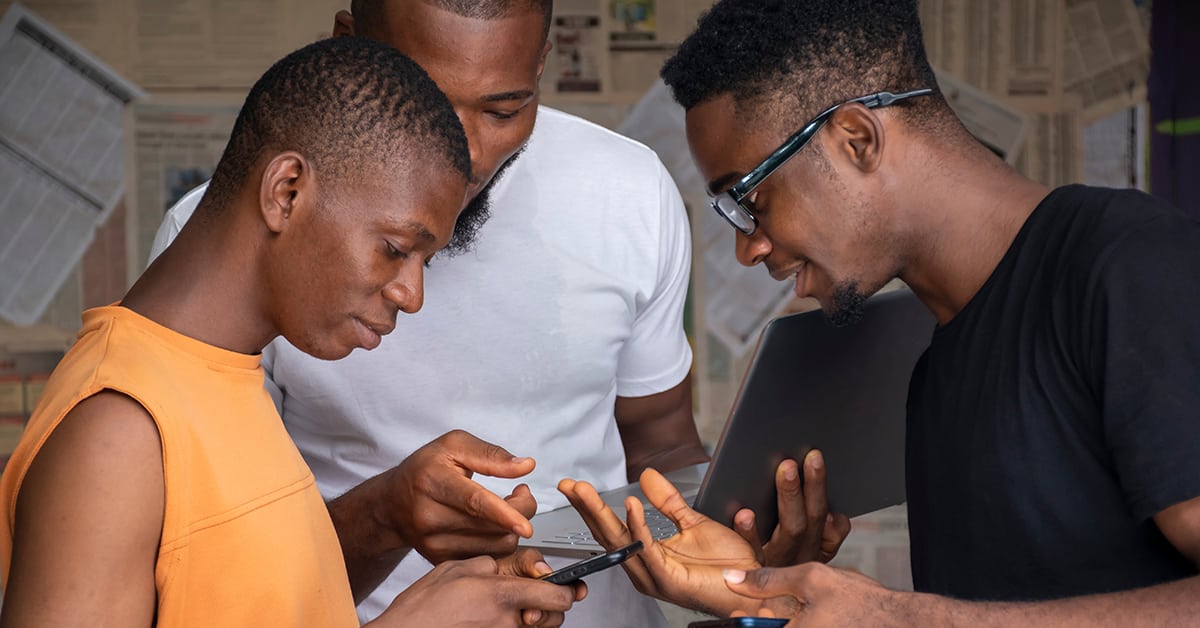The digitization of payments is transforming African economies, but challenges remain.

Somalia is deliberate in growing mobile money access to its people, explains Abdilahi Ali, who steers the Central Bank’s monetary and regulatory policies.
“As we rebuild our nation, we are aware of the fact that we are operating in an environment where 98% of our currency is counterfeit.” Ali says, citing the ramifications of a devastating civil war and a collapsed financial system, with the statistic initially provided by the IMF, with the Bretton Woods institution further claiming the remaining 2% of the money said to be tattered.
In fact, 70% of adult Somalis use mobile money services regularly, the World Bank says. Globally there are now 310 mobile money services in 96 countries; 171 of those services are in Africa, and 157 are in sub-Saharan Africa specifically, according to the Global System for Mobile Communications Association (GSMA). 2021 State of the industry Report on Mobile money.
“Digitization of payments has increased transparency and reduced the cost of financial transactions, leading to greater efficiency and economic growth. Once a payment system is working effectively and efficiently, it becomes a game changer to an economy,” says Njuguna Ndungu, cabinet secretary, of Kenya’s National Treasury and Economic Planning.
Overall, Africa had a mobile money transaction value of $495 billion in 2020. That’s almost two-thirds of the global value of $767 billion, according to the GSMA, underlining that the region’s banking future is secured by monetary digitization.
Kenya and Ghana have moved fast to adopt digital payments, according to the Boston Consulting Group. Transactions made via mobile wallets were equivalent to 87% of the GDP in Kenya and 82% in Ghana. The report further estimated that mobile payments in Africa could rise from “$3.5 billion in 2021 to between $14 billion and $20 billion in 2025,” says Michael Mbuthia, East Africa regional director at AfricaNenda.
Sanjeev Gupta, a senior fellow at the African Center for Economic Transformation, says monetary digitization has had a positive impact on Africa. It provides more—and better—information to policymakers to formulate and implement regulations, particularly where national identify card schemes have been implemented. It also lowers the cost of administering taxes and makes it easier for citizens to comply with their obligations to pay taxes.
“Gradually, it is improving the reach of policymakers to provide benefits to the population,” says Gupta. “And most importantly, it is contributing to financial inclusion and allowing citizens to transfer funds using mobile-phone-based financial services platform. All in all, this is increasing the efficiency of financial system and expanding the ability of governments to provide public services at a lower cost and with less leakage—an important consideration where resources are limited.”
In sub-Saharan Africa, mobile money has seen exponential growth. The platform is touted as a revolutionary tool for expanding access to financial services in low-resource environments. With just a mobile phone, users are able to hasten transfer of money at low cost and without needing access to an existing banking account.
The uptake of digitization of payments has varied across African states, with some countries showing a high degree of adoption and others lagging behind, says Njuguna.
The key challenge is providing a stable and predictable policy framework for financial service providers to follow. It is equally important to have a stable macroeconomic environment where countries manage their fiscal and external policies without creating undue imbalances that lead to frequent changes in policies, says Gupta.
In addition, Gupta says there are over 20 countries in sub-Saharan African that currently have adjustment programs with the IMF and many more are in discussion to have a program.
“Many countries are at risk of or in debt distress, which would require a major realignment of their macro policies,” Gupta says. “The debt-to-GDP ratio has grown sharply since 2010, which has meant a large share of their tax revenue are allocated to pay interest on debt.”
One of the regions where digitization of payments has taken off is East Africa, particularly in Kenya and Tanzania, where mobile money platforms such as Mpesa have been widely adopted, largely due to high penetration of mobile phones and limited traditional banking infrastructure in these countries, which makes digital payments a more viable option for many people.
“This effort was driven by the need to change the financial services design for low-income cohorts,” says Njuguna.
According to Mbuthia, African governments are applying interesting use cases to help scale payment services with the aim of engaging a broader customer base.
“Demand and supply considerations greatly affect uptake of payment technologies. When a country has extensive mobile penetration, the uptake of digital financial services will be higher,” says Mbuthia. “Factors affecting the supply side will include favorable regulatory regime, which would help scale up payments.”
Today, Africa is home to more digital financial services deployments compared to any other region in the globe, with almost half of the nearly 700 million individual users worldwide, according to the International Monetary Fund.
Mobile money solutions and agent banking now offer affordable, instant and reliable transactions, as well as savings, credit and even insurance opportunities in both rural villages and urban neighborhoods where there are no bank branches.
“The uptake of digital technologies is uneven across Africa. Countries with stronger institutions and stable governments and relatively stable macroeconomic policies have made bigger progress in this area,” Gupta says. “For example, Kenya remains on the forefront in adopting digital technologies. Countries that are viewed as fragile, such as Burkina Faso and Niger, are slower in adopting digital technologies.”
Africa tends to embrace innovation at scale and leapfrog into the future of digital payments, according to Andres Pérez, director of the Fintech Association of South Africa, though some African countries do not have the correct banking structure to allow them to adopt traditional payment methods such as cards.
“In markets like Nigeria, for instance, the growth of instant digital payments compared to card payments or mobile point-of-sale (mPoS) has been dramatic. In the first two months of 2022 alone, almost $130 billion (53.83 trillion naira) was transferred through NIPS, compared to only $2.7 billion (1.15 trillion naira) processed through PoS terminals,” says Pérez.
In West Africa, countries such as Ghana, Nigeria and Senegal have shown a high degree of uptake, driven by a large young population, high mobile phone penetration and increased awareness of digital financial services, says Njuguna.
He adds that countries in the Southern Africa region, such as South Africa and Namibia, have been slower to adopt digitization of payments, due in part to a more developed traditional banking infrastructure and a lower mobile phone penetration rate.
“Also, some countries in the Central Africa region, such as Cameroon and DRC, have been slow to adopt digitization of payments, due to a lack of regulations and infrastructure, as well as a lack of awareness of digital financial services among the population,” says Njuguna.
Lavina Ramkissoon, founder of the Fintech Association South Africa, says the 21st century witnessed dramatic shifts on how people pay for goods and services as electronic payments are increasingly displacing cash and, more recently, cryptocurrency and digital currencies emerging as alternatives to traditional conceptions of money.
But a challenge remains.
For Africa’s digital transformation to be seamless, there needs to be a harmonized environment that guarantees investment and financing. This, Ramkissoon says, would close the digital infrastructure gap that exists in Africa, achieving accessible, affordable and secure broadband across demography, gender and geography.
“Let’s add to the mix the culture of cash and offline payments due to no internet connectivity or power outages This contributes equally to the landscape,” says Ramkissoon. “By default, this implies more lives are impacted, uplifted and included in digital transformation for the continent.”



